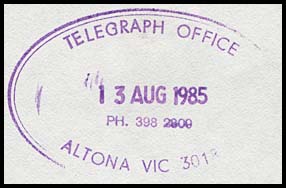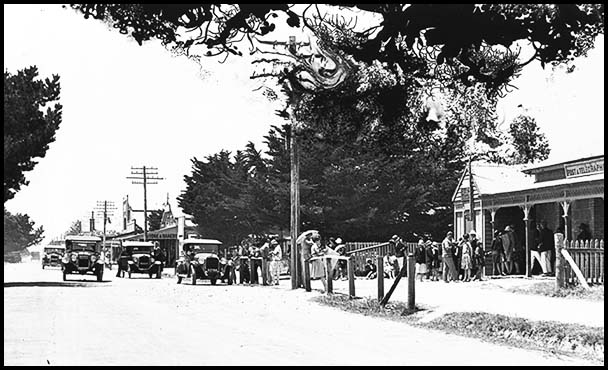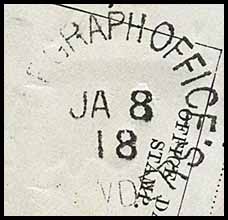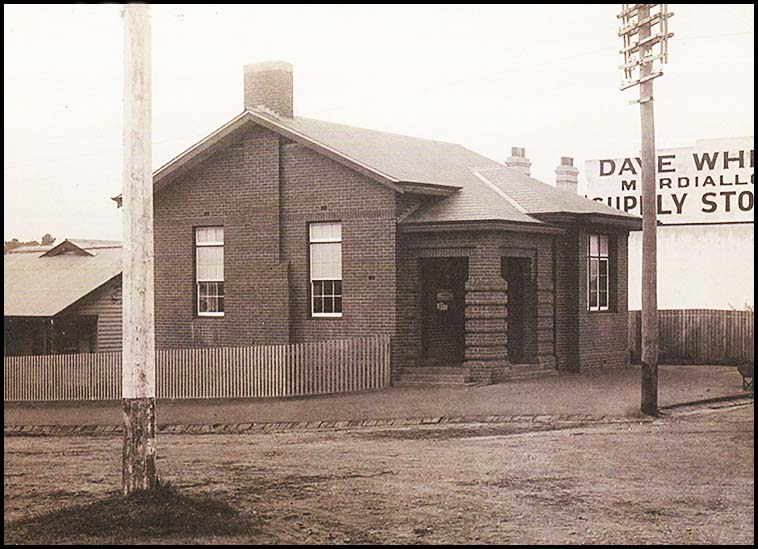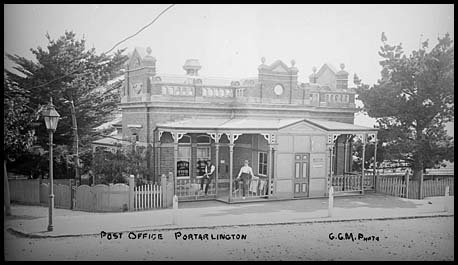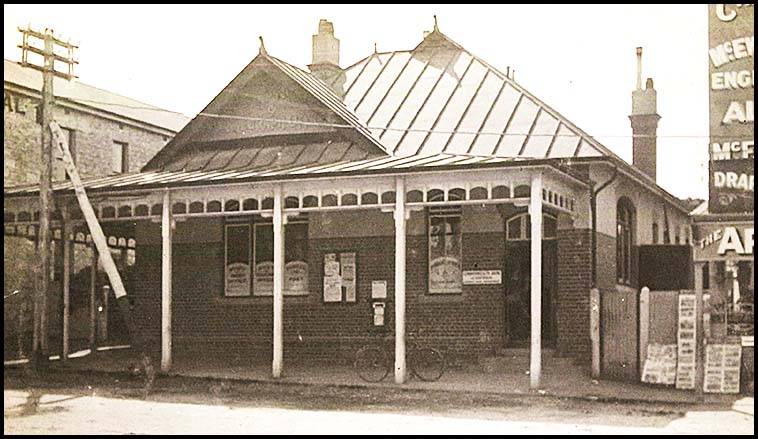Telegraph Offices on the Southern Coast line.
- Australia 1901-1988
- New South Wales
- Queensland
- South Australia
- Tasmania
- Victoria
- Western Australia
- International
- Special aspects
Three of the Telegraph Offices on the Southern Coast line - Williamstown, Geelong and Queenscliff were also on the first Victorian telegraph line and so are discussed in their respective entries there.
The following Telegraph Offices are included on this page:
| Altona | Bass | Cape Schanck | Dromana | Drysdale | Flinders |
| Frankston | Geelong | Highton | Mordialloc | Mornington | Newton |
| Point Lonsdale | Portarlington | Portsea | Queenscliff | Quarantine Station | Snapper Point |
| Sorrento |
| Altona.
The Office opened as a Receiving Office on 14 January 1918 and was reclassified as a Post Office about 1924. |
|
Two rubber oval TELEGRAPH OFFICE (RO2-TO) date stamp were issued to the office.
|
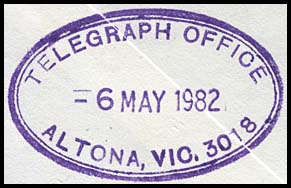 6 May 1982 (earliest recorded date). |
|
|
|
The Post Office opened in June 1862 while the Telegraph connection was made in the mid 1890s. The Great Southern Advocate of 6 January 1899 reported: "At about 3 o'clock on Saturday morning, 31st December, the Post and Telegraph station was burnt to the ground. Miss West held the position of Post aud Telegraph Mistress. Every thing connected with the above government department was destroyed. Nothing was saved from the burning ruin and all furniture and other costly effects in the house that money can never replace. Dr. Healy and his wife were residing with Miss West and they have lost everything, including some valuable furniture, surgical instruments, drugs, papers, books and diploma. The doctor's gold watch and chain were also burnt. The inmates did not even save a vestige of their clothes. Miss West has lost a very valuable piano and buggy. Much sympathy is expressed for the sufferers by this sad loss at the close of 1898. The cause of the fire is wrapt in mystery. An inquiry will be held". |
| Cape Schanck.
A Lighthouse had been built at the Cape in 1859 - and was the second lighthouse on the Victorian coastline. On 8 January 1861, the Gazette annouced that a tender had been accepted from Wm. Bolger to construct a Telegraph Office at Cape Schanck for £636 4s. On 1 February 1861, Frederick Bryan was appointed Manager of the new Telegraph Office at Cape Schanck. From 1st of August, 1861 Thomas Reed, was Gazetted as Manager of the Telegraph Office at Cape Schanck to replace the late Frederick Bryan. The Telegraph Office opened in September 1861. The Ballarat Star of 6 September 1861 reported that "Mr Bechervaise informs us that the electric telegraph station, Cape Schanck, was opened to the public yesterday" - a good source of information for the Star!! In the Legislative Assembly of 20 September 1861,:
The Leader of 1 March 1862 reported an unusual incident: "A telegram was received on Monday, by the Chief Secretary, from the manager of the Electric Telegraph station at Cape Schank stating that, on Saturday evening, reports of cannon were distinctly heard off the Cape. It was at first feared that some vessel might have gone on shore or have been in distress; the weather being very thick and hazy at the time. On Tuesday, however, it was ascertained that the reports were occasioned by the ship Star King, who was signalling for a pilot, and by the Corsair pilot-boat, who answered her in a similar manner". In March 1879, the Office was upgraded to a Post Office but still with telegraph functions. |
|
| The usual postal date stamp was used for Telegrams: | 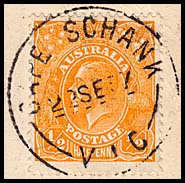 22 September 1937. |
|
Telegraph Office opened in April 1875. In early February 1877, "owing to the immense bush fires which are raging in the ranges between Dromana and Melbourne, the telegraph line has been interrupted and the Tasmanian telegrams, on Thursday night, had to be brought on from Dromana by the steamer Williams". "By 31 July 1878, a major difference had divided the community into two distinct groups - those who wanted to move the Post and Telegraph Office to another place and those who wanted to remain where it was. The aguments had apparently became quite acrimonious. At that stage "The question of the removal or non-removal of the Post and Telegraph Office, Dromana, from its present site has been the absorbing topic for some time past. The proposals from the two deputations who had recently waited upon the Postmaster General were brought to a close on Saturday last by the Postmaster General. He intimated that, having considered the statements made by the members of the two deputations which waited on him in the matter, he was satisfied that he would best consult the convenience of the greater number of people transacting business at the office in question by not acceding to the prayer of the memorial of those who desire to have it removed to the township. Now that this cause of discord was removed, it was to be hoped that the inhabitants will become more united and turn their attention to matters affecting some substantial improvements for the general welfare of the district". On 24 June 1905, advertisements were placed in newspapers and the Gazette for offers from persons willing to undertake the management of the Post and Telegraph Office, Dromana for a period of three years. |
|
Personnel: June 1879: "Mrs. Palmer, who has been some time assistant Post and Telegraph mistress at Prahran has, we are glad to learn, received a well-merited promotion to the charge of the Dromana offices. Whilst at Prahran, her constant study was to accommodate the public in every possible way, by which she had gained the good wishes of the inhabitants of the town". |
|
The Post Office was renamed from Bellarine on 7 January 1862. A Telegraph Office was opened in conjunction with the Post Office in August 1882. A Telegraph Office had also been opened at the Railway station in December 1879. One source suggests it closed 1916. The Geelong Advertiser of 8 May 1873 reported an early development:
Always great news when elections are coming. On 14 March 1874, Mr.Hopkins addressed a meeting of electors at Drysdale: "The candidate proceeded to give an account of his proceedings in Parliament. He said he was a conscientious protectionist ... He was not in favor of payment of members. He was in favor of assisted immigration, as well as the extension of railways, and thought it was highly desirable we should have a railway from Geelong to Queenscliffe via Drysdale ... In reply to the chairman, he would be in favour of a telegraph line to Drysdale and, if the Drysdale people could induce the Treasurer to occasionally visit their locality, they may succeed in obtaining a telegraph as well as Birregurra". On 21 April 1874, the Geelong Advertiser reported that "It appears that the Government are willing at last to entertain the idea of extending the electric telegraph to Drysdale, an official having been sent down to report on the advisability of doing so". On 20 December 1881, the Geelong Advertiser reported that "in deference to the prayer contained in a requisition, signed by inhabitants of the township of Drysdale and district, I hereby convene a public meeting, to be held at Drysdale on Wednesday, the 2lst December, in the Shire Hall, at 7.30 p.m., to consider on the best means of securing the establishment of a Telegraph Office in the township; its present position is, it is alleged, inconvenient and unsatisfactory". On 11 January 1882, the Geelong Advertiser reported "a deputation urged that a Post and Telegraph Office should be established in the township of Drysdale. The telegraph line passes through Drysdale to Portarlington. It was urged that the district was a flourishing one and that a Telegraph Station was absolutely necessary and that it could be well combined with the Post Office. The Minister promised to favourably consider the request at an early date." |
|
| Flinders. (Special line) The Telegraph Office opened in May 1869 to serve as the Victorian end of the 2nd Tasmania-Victorian submarine cable. It did accept telegrams for transmission to Victorian or other Colonial addresses and these were described as "local collections only". By 1877, these transmissions amounted to about 5 per week. |
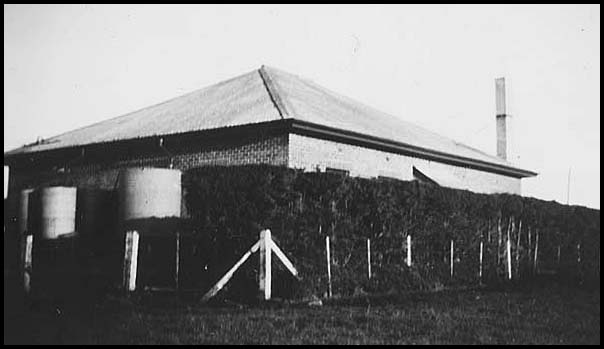 Flinders Cable Station. |
||
An unframed circular steel TELEGRAPH OFFICE/ FLINDERS date stamp was issued to the Office:
|
Used on VI-RO-3B. |
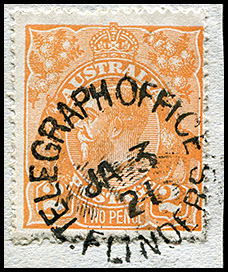 3 January 1921. |
|
| Frankston.
The Telegraph Office opened in October 1880. Life in Frankston was never meant to be dull or conventional. As an example of the best tourist promotion for Frankston before "Where the bloody hell are you?", the Avoca Mail of 10 February 1880 reported: "The Happy Land Excursion took place on Friday, as announced, and after a pleasant trip the party reached Frankston where a stage was erected on the grass and the prohibited play way was performed, to the great amusement of the excursionists. At the luncheon on the steamer, Mr Gaunson proposed "the health of the Moribund Ministry" and the toast was drunk in silence - the band playing the Dead March in "Saul". No wonder the Telegraph Office had to open so soon after!!! |
The Office was issued with a rubber rectangular TELEGRAPH OFFICE date stamp (RRH1-TO).
|
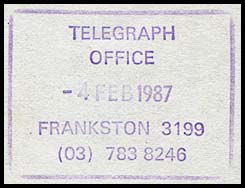 4 February 1987. |
|
|
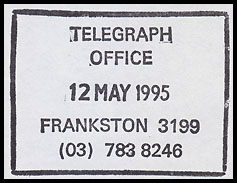 12 May 1995. The date indicates this is probably an archival date stamp. |
| Highton.
Highton is very close to Geelong West and Newton is between them. The Telegraph Office opened The Post Office had opened on 1 December 1864. |
|
|
The Telegraph Office was issued with a T. O. Highton date stamp:
|
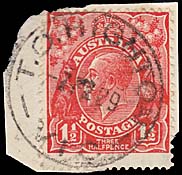 7 February 1929.
|
|
| Cover with T.O. Highton date stamp of 7 July 1917.
Addressed to Private Higgins at Macleod/ Mont Park. In 1917, Mont Park was a Military Hospital at the Macleod Military Camp but it later became a lunatic asylum. Very early use of the date stamp. |
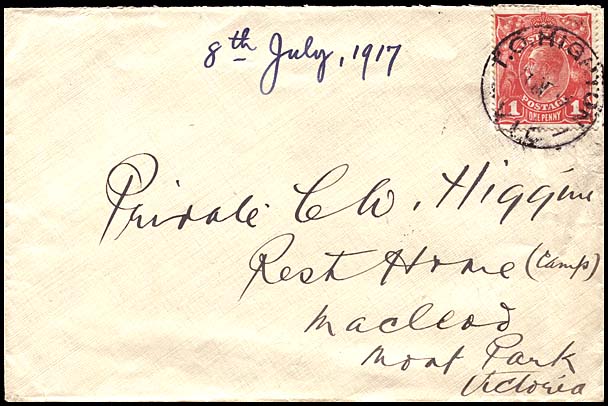 Provenance: Arthur Gray. |
|
|
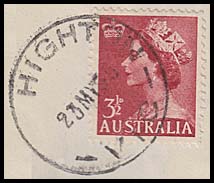 23 May 1956. |
|
|
The Telegraph Office opened in August 1876. |
||
|
||
On 31 October 1872, the Melbourne Punch described Mordialloc as follows: "Mordialloc, like Williamstown, is a fishing village. A few fishermen with nets catch a few schnapper and flatheads, but their net profits are not large, therefore the place is not financially a piscatorial success. The visitors supply the loaves and the fishes as well ... (after leaving Cheltenham) the Mordialloc-bound bus-passenger begins at last to feel that he can breathe and move. More red dust, very bushy bush for a few miles and at last he reaches the destination. If he goes on Sunday, and is hot, thirsty, dusty and tired, he will find a difficulty in getting the wherewithal to transmit the grit from his mouth into his viscera, unless he lights upon the lucky public, the fortunate owner of which has never to face the beak. He inspects the beauties of the place, cuts his boot with a broken bottle, bathes, eats his luncheon, if he brings any, or goes to the " meals at all hours" house and manages a meal, certainly clean, copious, comfortable and cheap. But if he wishes to command unlimited P. B.'s, countless beers, porters without number, and port and sherry at discretion, he can go down on Saturday, engage a bedroom at one of the "pubs," and his rectitude is even as ninepence. All things have an end and so have visits to Mordialloc. The tourist returns as he came. He takes his seat in the "bus" and finds two ladies, three babies, and several bunches of flowers in previous occupation. As he goes along more matrons, more flowers and more babies get in and, by the time he arrives at the Bay Street station, he is impregnated with the flavor of the babies, the fragrance of the flowers or is crammed with the domestic history of the matrons. He knows all about SAM'S bout with the scarlet fever, little BILLY'S biliousness, TOMMY'S tootliecums, FRANK'S fractiousness and MABY'S measles. He hears a little about the peccadilloes of papas and the general failings of fathers. How SMITH neglects the children and grumbles at the boot bills, and the precise manner in which stingy SNOOKS wonders how the house cannot be "kep" on a pound a-week; where calico, only a little soiled, can be bought cheap, and the best place for the purchase of alarming sacrifices. Again in the train, the traveller is brought into unpleasantly close contact with sticky children of over two years and bread-and-buttery ones under that age and what, with the sickliness of the flowers and the crammed carriages, he is devoutly thankful when Flinders Street is reached in safety. With all the drawbacks, he determines to again essay Mordialloc for, in its pleasing solitude, he can cast off the cares of business and, for a brief moment, forget that there is such a thing as having to meet a bill or coax a creditor into giving a little more time". SO!Pray tell dear reader - if you know Mordiallac - have things changed for the better? |
||
The Office was issued with two formats of rubber rectangular date stamps - one with TELEGRAPH OFFICE and the other with TELEGRAPH:
|
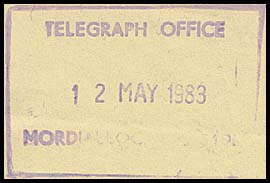 12 May 1983. |
|
|
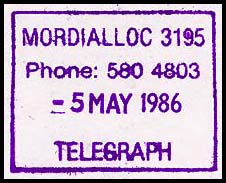 5 May 1986. |
|
|
Newton is very close to Geelong. It also contains Chilwell. It is not connected to Newton-Scarsdale near Ballarat. As the telegraph lines to the Southern Coast were being constructed, a test box was established at Newton. Hence about the 1890s, a Telegraph Office was also opened at Newton. |
|||
The Telegraph Office was issued with a T.O. Newton:
|
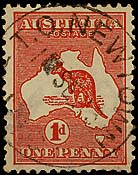 1 September 1913 (early usage). |
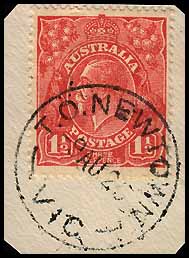 9 August 1926. |
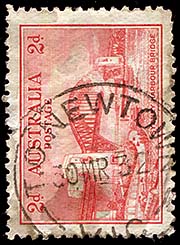 30 March 1932. |
|
Point Lonsdale was a most significant lighthouse and beacon for guidance of ships passing in or out of Port Phillip. On 8 January 1861, the Gazette annouced that a tender had been accepted from Wm. Bolger to construct a Telegraph Office at Point Lonsdale for £636 4s. In The Star of 14 September 1861, "Mr. Bechervaise informs us that the electric telegraph signal and look-out station at Point Lonsdale will be opened to the public during the ensuing week". The Geelong Advertiser followed up that announcement with "On and after tomorrow the Electric Telegraph station at Point Lonsdale will be in charge of a lady, Miss Green. This is a novelty in this part of the world, but in Europe, the great majority of telegraphists are females. We are informed that several of the softer sex are now being taught in Melbourne the mysteries of telegraphing". In 1862, two new rocky outcrops were discovered outside Point Nepean. The instructions to Masters of vessels, pilots and others navigating the entrance of Port Phillip as to the whereabous of these outcrops and how to avoid them were expressed in terms of taking note of the locations of Point Lonsdale - last part of this reference from the Gazette. A new light on Point Lonsdale came into operation on 3 February 1863. The Ballarat Star of 4 December 1867 tells a lovely story - extracts being: "I met with an old salt today who is signal-master at Point Lonsdale, at which lively spot he settled down some five years ago. He claims to be the first Victorian to dip his colors to the Galatea and have the usual nautical bow in return ... It may interest some of your female readers to know that the oid man's niece is in the Civil Service with a salary of a hundred and something as Mistress of the Telegraph Office at Point Lonsdale. The old man dips his colors and trims his lamp and the niece clicks the telegraphic keys; the happy pair making a snug living and in a desperately quiet, though gravely responsible way". A major wreck off Port Lonsdale of The Light of the Age on her voyage from Liverpool to Melbourne was telegraphed (by Miss Green?) on the morning of 16 January 1868. |
|
The Telegraph Office opened in January 1877. By 1897, there was also a savings bank and a money-order office. |
| Quarantine Station. (Sorrento line). The Telegraph Office opened in October 1884 at the second location of Point Nepean. It was classified as a Post Office from about 1916 to 1 July 1922. In 1849, Governor LaTrobe has authorised the establishment of a hospital camp or Quarantine Station at Red Bluff (now Point Ormond). In 1852, with the arrival of the S.S. Ticonderoga carrying 300 people infected with fever. Plans to establish the Point Nepean site were accelerated. In the Legislative Assembly of 14 March 1860, Mr. Nicholson laid upon the table a return respecting the Quarantine Station at the Heads. He also noted that the expense of the station for the four years ending December 1859, had been £5,073. More than £1,000 of that amount had been recovered from owners of ships which had been placed in quarantine. Before the construction of the telegraph line to the station, messages had to be taken by boat to Queenscliff and then relayed to Melbourne. The establishment of the Telegraph Station at the Quarantine Station was precipitated by a small-pox infection suffered by a passenger - Miss Kermode - aboard the R.M.S. Rome in April 1884. The establishment appears to have been thought of and informally made within hours. For full details, see elsewhere. For full details of the Quarantine station, see The Nepean Historical Society webpage. |
|||
| A TEL. OFFICE/QUARANTINE STN. date stamp was issued to the Telegraph Station:
Used: 14 January 1908 to 13 May 1919 Diameter: 25 mm. Rated: RRR. Number in the Census: 5. |
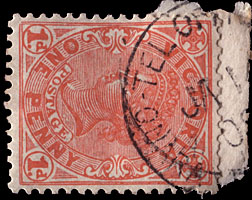 14 January 1908. |
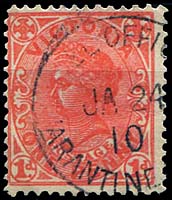 24 January 1910. |
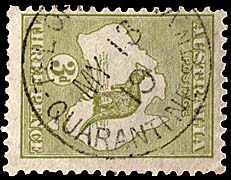 13 May 1919. Used during the Spanish Flu pandemic. |
